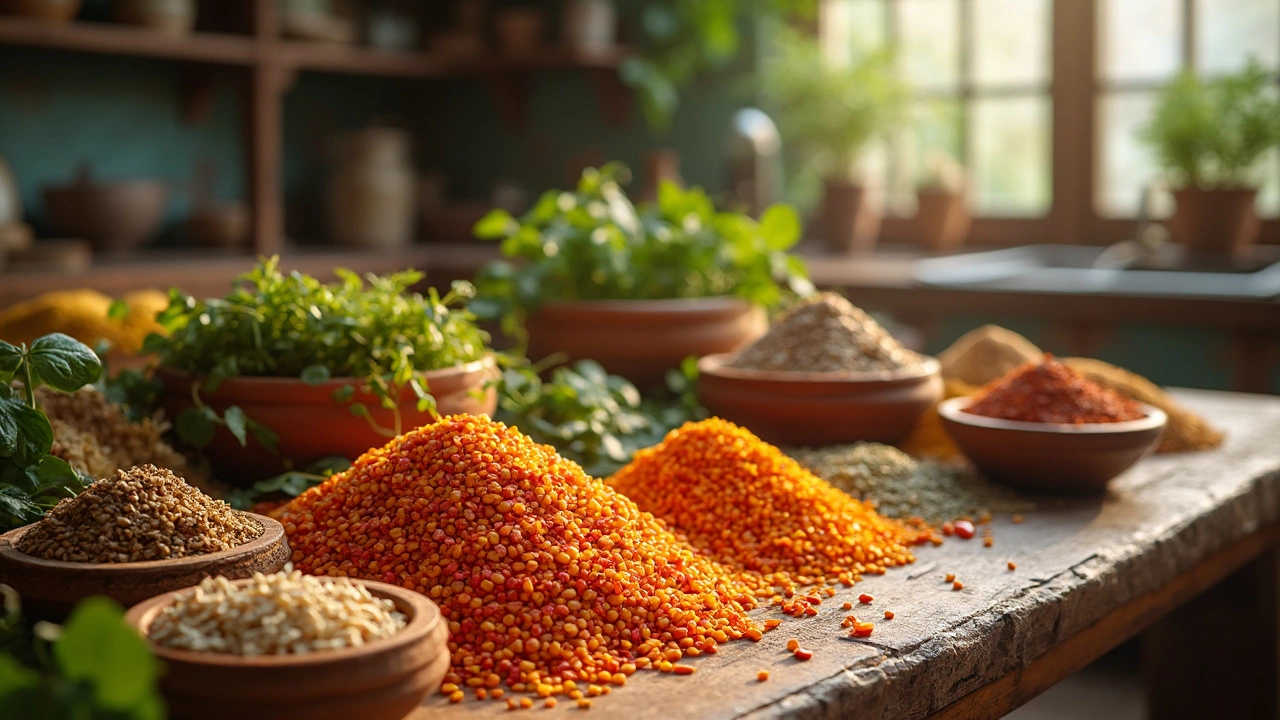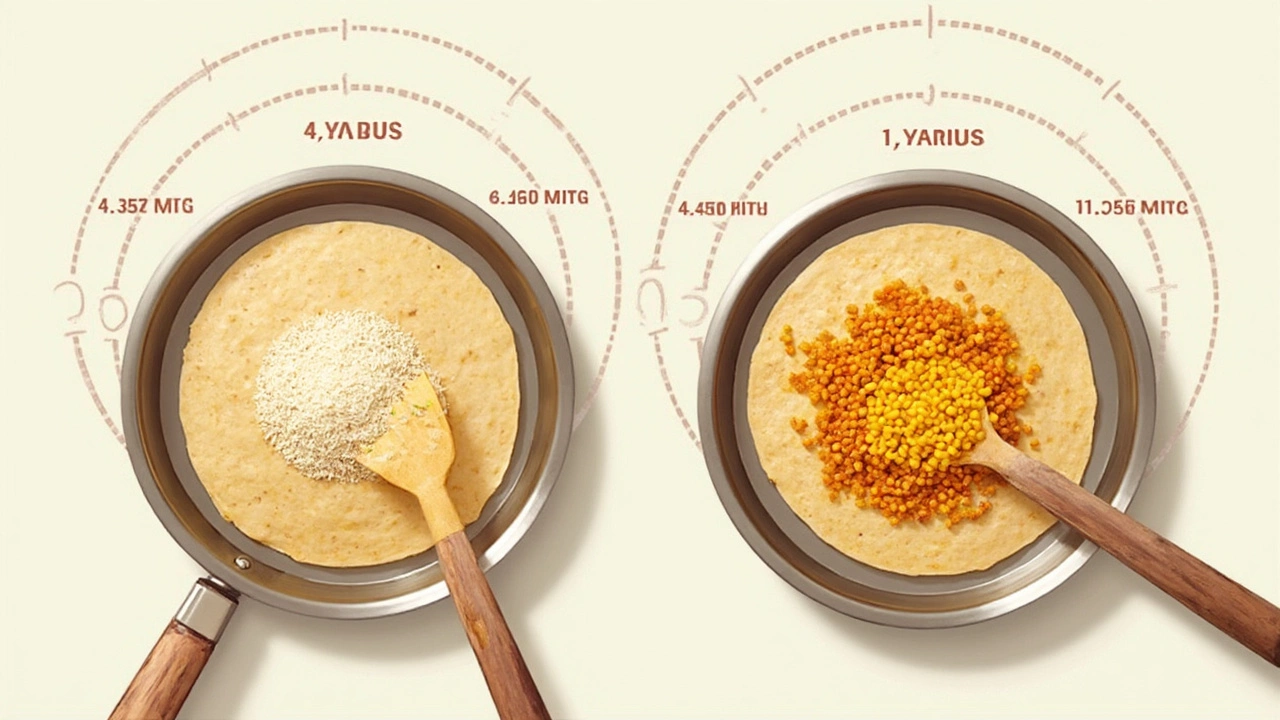How to Reduce the Glycemic Index of Dosa
 Apr, 15 2025
Apr, 15 2025
Everyone loves a good dosa, right? But if you've got an eye on your sugar levels, you might worry about the glycemic index (GI) of this tasty South Indian staple. Luckily, there are smart ways to tweak your dosa recipe to make it friendlier for those watching their carbs.
First off, let’s talk about the ingredients. Using whole grains like brown rice, millet, or quinoa can go a long way in reducing the GI. These grains break down slower in your body compared to polished white rice.
- Understanding Glycemic Index
- Choosing the Right Ingredients
- Fermentation Tips
- Cooking Techniques
- Flavor Without the Sugar Spike
Understanding Glycemic Index
Alright, so let’s break it down. The glycemic index, or GI for short, is basically a measure of how fast or slow a food causes your blood sugar to rise. It goes from 0 to 100, with pure glucose pegging the top spot at 100. Foods with a high GI (70 and above) can cause quick, sharp spikes in your blood sugar.
Why does that matter for your dosa recipe? Well, if you're managing diabetes or just trying to keep your energy levels steady throughout the day, it's better to have foods that are absorbed more slowly. This ensures a gradual increase in blood sugar without the 'sugar rush'.
Cynthia Sass, a registered dietitian, says, "By choosing ingredients with a lower glycemic index, you can make traditional recipes healthier and more suitable for a balanced diet."
Here's something to think about. Dosas made with white rice typically have a higher GI. Now, swap that with brown rice or millet in your dosa batter recipe, and you'll notice a difference. That's because these ingredients have more fiber, which slows down digestion.
If you're interested in the numbers, here's a quick snapshot:
| Ingredient | Glycemic Index |
|---|---|
| White Rice | 73 |
| Brown Rice | 50 |
| Millet | 57 |
So, next time you're preparing that scrumptious dosa, remember that these small changes in ingredients can have a great impact on the glycemic index and, ultimately, your health.
Choosing the Right Ingredients
Want to give your dosa a healthier spin? It starts with picking the right ingredients. The base of your batter is a game-changer. Instead of sticking to the usual white rice, consider opting for grains with a lower glycemic index. Swap it out for brown rice, quinoa, or even millet. These alternatives are not only nutrient-rich but also break down more slowly in the body, keeping those sugar levels steady.
Next up, think about the dal. While urad dal is a classic choice, mixing it up can help too. For example, throw in some chana dal. It's not just lower in GI, but it also adds a nutty flavor to your dosa recipe. You end up with a batter that's as tasty as it is healthy.
Don't forget about the extras. Adding in spices and seeds can not only bump up the flavor but also support your health goals. Consider ingredients like fenugreek seeds, which can improve digestion and help regulate blood sugar.
- Whole grains: Brown rice, millet, quinoa
- Dals: Use a mix of urad dal and chana dal
- Spices and seeds: Fenugreek seeds, cumin for better digestion
By making these small yet smart swaps, you'll have a healthy dosa batter that's just as satisfying, without the sugar spike. And trust me, you'll barely notice the difference in taste, but your body will thank you for it!

Fermentation Tips
Getting the fermentation of your dosa batter just right can work wonders for its glycemic index. A well-fermented batter not only makes your dosas tastier but can also make them healthier. How, you ask? Fermentation breaks down carbs and makes them easier to digest, potentially lowering the overall GI of your dosa.
Here’s the trick: Let your batter sit in a warm place. Ideal fermentation happens between 25 to 30 degrees Celsius. If you're in Bengaluru, you might get away with just leaving it out on the counter overnight. But if it’s a chilly day, consider placing it in the oven with just the light on.
Using a mix of grains is another smart move. A blend of urad dal and whole grains like brown rice can be fermented just like the traditional batter. This mix ferments well and gives a nice balance by not spiking your blood sugar levels.
For those who love numbers, here's a nifty bit: a study found that fermenting cereals can reduce their GI by up to 39%! That’s some sweet dose of science right there.
- Keep the batter consistency just right, not too thick or watery. It bubbles better with the right texture.
- Don’t skimp on the salt; it helps in fermentation.
- If after a day your batter isn’t as bubbly as you’d like, give it a mix and let it sit for a few more hours.
These simple dosa batter recipe tweaks could just be the difference between an indulgent breakfast and a wholesome meal fitting for those watching their sugar levels.
Cooking Techniques
Once you've sorted out your ingredients for a healthier, lower glycemic index dosa, the next step is all about how you cook it. Here’s where you can make or break your efforts. Let's simplify this!
First, make sure your pan or tawa is hot enough before you pour the batter. This step ensures that the dosa will cook quickly, sealing its moisture and nutrients inside without overcooking it. When the batter hits the tawa, it should sizzle immediately.
Use a minimal amount of oil, just what’s necessary to keep the dosa from sticking. The goal is to achieve that lovely crispy edge without soaking your dosa in oil. If you're health-conscious, investing in a good quality non-stick pan can help you reduce oil usage even more.
Cook the dosa on medium heat. High heat might work faster, but keeping it moderate allows the dosa to cook evenly throughout, reducing the chance of burning and losing nutrients. Flip it gently and let it cook a little on the other side just enough to ensure there’s no raw batter.
To make the dosa fluffier and easier on the stomach, consider using a lid to cover the pan just for a short burst. This traps steam and softens the inside without raising the glycemic index.
By the way, here’s a quick side note: Making thin dosas, like paper-thin crispy ones, tends to keep the GI lower than making them thick. Less batter equals less digestion time. So, less batter spread thinly across the tawa can be a neat trick.
All these cooking techniques go hand in hand to ensure your efforts to cut down the glycemic index aren't wasted on the stove. A little attention to detail can make your favorite dosa recipe a healthier choice.

Flavor Without the Sugar Spike
You might be wondering, how can I make my dosa both healthy and super tasty? Well, the good news is you don’t have to sacrifice flavor while keeping the glycemic index in check.
Think about spices and herbs. Adding ingredients like cumin seeds, curry leaves, and even a hint of fenugreek can amp up the flavor profile without nudging the sugar levels high. These spices not only bring aroma but are known to support digestion, which is a win-win.
Next, dips and sides make a huge difference. Instead of coconut chutney, which can be high in fats, you could try using chutneys made from coriander, mint, or even tomato. They bring zest to your dosa experience with minimal calorie stress.
Still craving more taste variations? Experiment with the filling. A veggie-packed masala mix using sweet potatoes or carrots can offer sweetness without the sugar rush. Additions like these are not just about flavor; they're about smart eating too.
- A bit of protein like paneer or tofu can also be tossed into the mix for a balanced meal.
- Remember, balance is key. A bit of healthy fat like a sprinkle of sesame seeds on your dosa can provide a full-bodied flavor that sticks without the sugar surge.
So next time you're flipping dosas on the skillet, get creative! Adjusting the flavors while managing the glycemic index can help you enjoy this traditional dish with a modern, health-friendly twist!